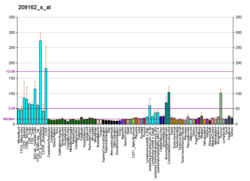| PRPF4 | |||||||||||||||||||||||||||||||||||||||||||||||||||
|---|---|---|---|---|---|---|---|---|---|---|---|---|---|---|---|---|---|---|---|---|---|---|---|---|---|---|---|---|---|---|---|---|---|---|---|---|---|---|---|---|---|---|---|---|---|---|---|---|---|---|---|
| |||||||||||||||||||||||||||||||||||||||||||||||||||
| Identifiers | |||||||||||||||||||||||||||||||||||||||||||||||||||
| Aliases | PRPF4 , HPRP4, HPRP4P, PRP4, Prp4p, RP70, SNRNP60, pre-mRNA processing factor 4 | ||||||||||||||||||||||||||||||||||||||||||||||||||
| External IDs | OMIM: 607795; MGI: 1917302; HomoloGene: 3446; GeneCards: PRPF4; OMA:PRPF4 - orthologs | ||||||||||||||||||||||||||||||||||||||||||||||||||
| |||||||||||||||||||||||||||||||||||||||||||||||||||
| |||||||||||||||||||||||||||||||||||||||||||||||||||
| |||||||||||||||||||||||||||||||||||||||||||||||||||
| |||||||||||||||||||||||||||||||||||||||||||||||||||
| |||||||||||||||||||||||||||||||||||||||||||||||||||
| Wikidata | |||||||||||||||||||||||||||||||||||||||||||||||||||
| |||||||||||||||||||||||||||||||||||||||||||||||||||
U4/U6 small nuclear ribonucleoprotein Prp4 is a protein that is found in humans and encoded by the PRPF4 gene. [5] [6] [7]
The removal of introns from nuclear pre-mRNAs occurs on complexes called spliceosomes, which are made up of 4 small nuclear ribonucleoprotein (snRNP) particles and an undefined number of transiently associated splicing factors.
PRPF4 is 1 of several proteins that associates with U4 and U6 snRNPs.[supplied by OMIM] [7]





